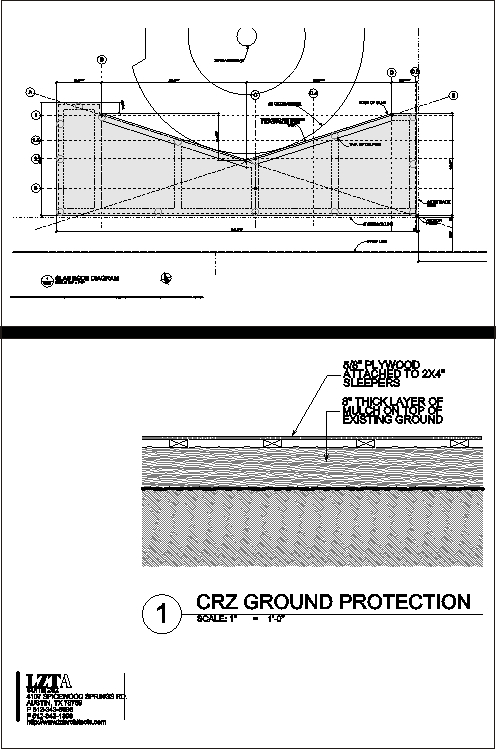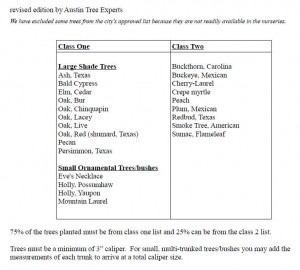Assessing tree risk is one of the more complex functions certified arborists must perform. The simple fact is that tree failures are, in large part, unpredictable. To help our profession, the International Society of Arboriculture (ISA) has developed some standards to the process of evaluating tree risk and there is now a “qualification” for arborists to acquire. Being the inquisitive individual that I am, I’ve attended the class and passed the test to become TRAQ qualified. Continue reading ISA Tree Risk Assessment Qualification (TRAQ)
Category: Construction Sites
Using Trees for Stormwater Runoff Mitigation
For many years, the arborist community has been touting the great benefits trees offer to the urban environment. I think everybody in the world agrees with this from the surface level. One of the deeper discussions on this topic is the value of stormwater-runoff mitigation that trees can provide. However, nearly every time I’ve tried to bring up this topic in a planning Continue reading Using Trees for Stormwater Runoff Mitigation
Heritage Tree Ordinanace in Austin
The city of Austin heritage tree ordinance was adopted back in February of 2010. The new ordinance expands upon the existing tree protection ordinance creating a new “class” of protected size tree. Continue reading Heritage Tree Ordinanace in Austin
Kolkhorst Anti Tree Bill
Just today, one of my respected colleagues, Heather Brewer, a municipal forester in the City of Georgetown, turned me on to a bill that is being introduced by Republican house member Lois Kolkhorst. Kolkhorst is from Brenham, TX. Her proposal aims to put maximum limits on tree mitigation that a government entity can require. And, the proposal prevents a municipality from enforcing tree protection in extra-territorial jurisdictions. As much as we all hate complicated law, there is a need for it. Expecting us to all get along without rules is overly optimistic. So, I do think some variety of state regulation could be useful if the language is well written. However, this proposal raises an eyebrow on me for many reasons. Continue reading Kolkhorst Anti Tree Bill
Introducing Our New Mulch Calculating Tool
The purpose of the mulch calculator is to help you figure out how much mulch you need to buy for your mulching project. Mulch is conventionally sold by the yard. When you draw an area on the map it tells you how many yards of mulch are required to cover the area and also gives you some square footage calculations in case that is useful to you. There are some price calculations in there, but it’s really up to you to price shop and get the best deal you can.
Tree Removal Permit in Austin
Be careful before you remove a tree in your yard if you live in Austin. Many of the trees in Austin are protected. Possibly even some in your yard! The city’s tree protection ordinance is somewhat complicated. Here is some info to get you started.
- In residential settings, trees 19″ DBH (diameter at breast height, approx 4.5′) and larger are protected
- In commercial settings, trees 8″ DBH and larger are protected
- Trees 24″ and larger are classified with heritage status
- Removing or pruning out more than 25% of the canopy of a protected tree requires a permit
Working Within the CRZ of a Heritage Tree
The city of Austin is very demanding that you do not impact what is defined as 1/2 of any heritage tree’s critical root zone (CRZ) during construction and development processes. And, rightly so. If you are building around a tree and expect it to live, rooting area needs to be preserved. Unfortunately, sometimes the city’s CRZ protection requirements can really restrict design ideas and site use. During one particular project I worked on with David Carroll with LZT Architects, the design successfully avoided breeching the 1/2 CRZ of a heritage tree, however, the contractors needed a few feet of access around the edge of the new building. The problem was the design built right up against the 1/2 CRZ, which meant workers would need to work on top of the 1/2 CRZ; this is a no-no. To mitigate the access problems, the builder put down a stage of CRZ ground protection. This consisted of an 8″ layer of mulch directly on the natural grade with a stage made of 2×4 sleepers attached to plywood. This stage effectively buffers foot traffic from the root zone to protect the tree and allow workers to do their job.
Here is a pdf of the stage sketch

City of Westlake Hills Tree Ordinance Information
 On February 10, 2010 the City of Westlake Hills adopted a new tree ordinance. You can read the document in its entirety here. But, I’d like to offer you these important items in the ordinance.
On February 10, 2010 the City of Westlake Hills adopted a new tree ordinance. You can read the document in its entirety here. But, I’d like to offer you these important items in the ordinance.
- You must have a permit for any tree pruning if you hire a service. If you do the pruning yourself, there are some allowance, but you should contact Christy to keep yourself out of trouble.
- Trees up to 6″ diameter can be removed without permit.
- Trees 6″ and larger can be Continue reading City of Westlake Hills Tree Ordinance Information
Every Kid’s Dream Tree House – How to Build It
Who hasn’t dreamed of the most grand tree house imaginable? Trap door, zip line, bucket on a pulley to get your stuff up. Well, for a few lucky kids their dream came true. And, their dad cared enough about the tree to call me in for advice. He didn’t want the dream tree house to be the demise of the tree. There are techniques to employ to minimize the damage to your tree when building a tree house.
Continue reading Every Kid’s Dream Tree House – How to Build It
Landscaper’s Guide for Construction Site – Tree Ordinance Mitigation
As a landscaper, your job might not be to manage tree ordinance compliance, but planting trees from this specific list will help your client (the contractor) keep their costs down. Planting trees from the list below will count toward the tree mitigation fines. Any plantings that are done as a requirement to the landscape plan do NOT count toward tree mitigation. But, if you happen to plant above and beyond the requirements then the extra will count.

75% of the trees planted must be from the class one list; 25% can be from the class two list.
pdf version of list
Continue reading Landscaper’s Guide for Construction Site – Tree Ordinance Mitigation

